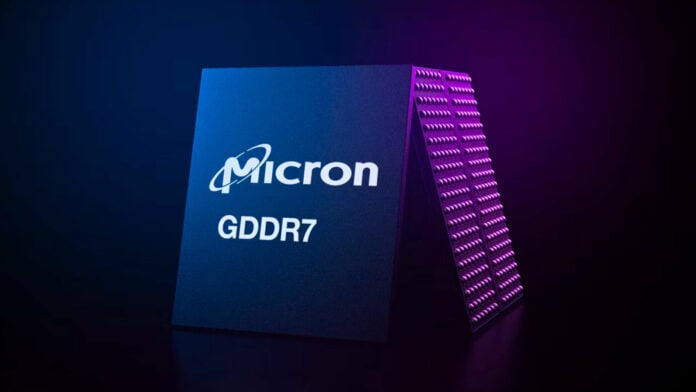GDDR7 is just around the corner and should arrive on most of Nvidia’s RTX 50 series line-up. The only question now is just how much the new video memory (VRAM) will improve over the previous generation. Fortunately, Micron has some numbers, and they’re pretty tasty.
Spotted by Harukaze5719 on X, the upcoming 32Gb/s flagship GDDR7 should offer a 30% improvement in frames per second over 20GB/s GDDR6 modules in both rasterised games and those cranking up ray tracing. We don’t know what tests Micron ran to get these figures, but it does state the comparisons run across 1080p, 1440p, and 4K. Since these benchmarks usually cherry-pick the largest figure, you can expect 30% more at HD than any other resolution. The same GGDR7 memory should also reduce generative AI wait times by up to 20% for image generation.
Micron states the improvements come from 1.5TB/s of system bandwidth thanks to its 32Gb/s modules. Highlighting just how much of a substantial jump this is, Nvidia GeForce RTX 4090 has 21Gb/s GDDR6X and hits 1.008TB/s.
Pair this with better power efficiency, and it’s an exciting prospect. GDDR7 claims a max 1.2V, down from 1.35V, and consumes 4.5pJ/bit of energy rather than 6.5pJ/bit. Smart engineering means you should see up to 70% reduced standby power and over 50% less power consumed during usage.
Of course, these comparisons use the top-end GDDR7. We’re not likely to see it on anything other than the best graphics cards in the upcoming line-up. They’re also Micron’s own claims and not necessarily what we’ll see in the real world. Nvidia will likely cut the bandwidth down as it has done on past generations to give headroom for better GPUs later down the line, be it an RTX 5090 Ti, Titan, or workstation cards. Until we get to stress test these modules out for ourselves, you should perhaps take these figures with a pinch of salt.
It’ll take a while before we see a full sweep of GDDR7. Whispers suggest AMD will stick with GDDR6 for its upcoming graphics cards, while Intel hasn’t revealed its plans for Battlemage. So far, there’s little competition for Blackwell architecture, which could widen Nvidia’s lead.


